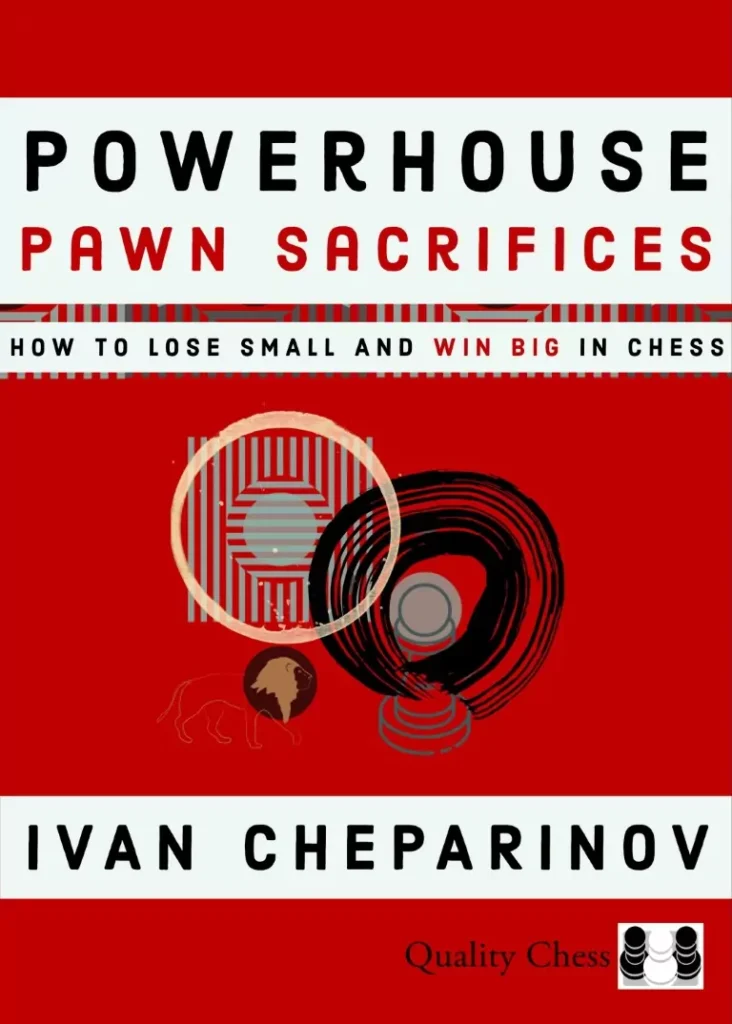In Powerhouse Pawn Sacrifices, Bulgarian Grandmaster Ivan Cheparinov delivers an outstanding fusion of autobiography, chess strategy, and deep tactical understanding through the nuanced lens of one of the most exhilarating motifs in chess: the pawn sacrifice. Based on a series of lectures initially presented at the Killer Chess Training Academy (2023–2024), this book is not just a guide, but a masterclass in attacking chess, translated beautifully into print by Quality Chess.

A Thematic Journey Through the Pawn Sacrifice
The book is structured into three main parts:
- Reasons to Sacrifice a Pawn
- Typical Cases
- How Do the Greats Do It?
In the excerpt provided, Cheparinov’s mastery is on full display in the first part—specifically, Chapter 1 titled Dynamics. Here, the author dissects games in which pawns are sacrificed not for immediate material gain, but for long-term dynamic advantages: open lines, faster development, tactical momentum, or simply more piece activity. This is not a dry technical exercise; it is a chess philosophy conveyed with clarity and passion.
Cheparinov frequently references his own tournament games, such as the brilliant and complex encounters against Viktor Bologan (Kemer 2007) and Ian Nepomniachtchi (Wijk aan Zee 2008). These aren’t mere annotations but interactive lessons. The narrative encourages the reader to pause and think, to treat the positions like exercises—some of which are thoughtfully provided at the start of each chapter to avoid premature exposure to solutions.
A Masterclass in Attacking Chess
The brilliance of this book lies in how it shifts the reader’s mindset. Too often, players at all levels cling to material as a measure of success. Cheparinov dismantles that belief with rigorous logic and practical examples. His analysis of the game Bologan–Cheparinov is a textbook example of how an early pawn sacrifice (with 9…g5 in the Sicilian) can lead to lasting pressure and eventual victory. The cascade of tactical motifs—ranging from rook lifts and exchange sacrifices to piece activity and tempo plays—is explored in detail.
In this game, Cheparinov notes a crucial learning point: “White, as most humans would do, clung on to the pawn with 20.♗b3?!… the best strategy is to find opportune moments to return that pawn and attain important positional goals”. That single idea—knowing when to return material—is pivotal in advancing from club player to master.
The Human Side of Sacrifice
While tactical brilliance is aplenty, Cheparinov never loses touch with the psychological side of the game. The book’s tone is deeply personal and pedagogical. He emphasizes the mental discipline required to embrace activity over material, especially under pressure. In one illuminating passage, he advises: “Once the stage is set, rarely should we change tack. The sacrifice of the second and third pawns was the only principled way to continue”.
This philosophy reaches its zenith in the analysis of Cheparinov–Nepomniachtchi, where Ivan sacrifices multiple pawns not just to attack, but to never pause. The initiative becomes a character in the story—unrelenting, punishing, and ultimately triumphant.
Educational Design
The book’s layout is thoughtfully constructed. Each chapter starts with exercises and puzzles that immerse the reader in problem-solving before the explanatory commentary begins. These puzzles aren’t perfunctory; they’re pulled from key moments in the games to maximize learning and challenge. The visual layout minimizes spoiler risk, encouraging independent thought before revealing the solutions later in the chapter.
The didactic strength of the book is further enhanced by frequent “Learning Points” sections that summarize key takeaways at the end of each example. These bullet points are gold for the reader who wants to digest complex ideas into actionable concepts. For example, one such takeaway teaches us that “open lines for our pieces are worth more than a pawn” and that “time, as in tempos, is also often worth more than a pawn”.
Visuals and Symbolism
Even the chapter opening visuals, such as the surreal artwork in Chapter 1 featuring melting clocks and knights (page 6), add an aesthetic and metaphorical dimension to the book. The imagery subtly reinforces the chapter’s theme—Dynamics—and evokes the temporal, sometimes surreal calculations demanded in practical play.
Editorial Excellence
Special mention must be made of editor Jeremy Hart and IM Kostis Megalios, who helped transcribe and transform Cheparinov’s lecture material into this polished, coherent text. The writing remains accessible without sacrificing complexity. Variations are deep but not overwhelming, and the author often flags lines that are “too theoretical” for the scope of the book—making it approachable for both intermediate and advanced players.
Final Thoughts: A Gift to Chess Literature
Powerhouse Pawn Sacrifices stands tall alongside modern classics like Jacob Aagaard’s Attacking Manual or Dvoretsky’s Endgame Manual. But it’s also unique. While many books teach openings or tactics in isolation, Cheparinov fuses opening strategy, middlegame planning, and tactical conversion through the prism of one central motif: the pawn sacrifice. This singularity of focus is what gives the book its power.
Whether you’re a tournament player looking to sharpen your killer instinct, or a club player seeking inspiration to play more dynamically, this book delivers. Every game tells a story, and every story teaches a principle.
Rating: ★★★★★ (5/5)
Ivan Cheparinov’s Powerhouse Pawn Sacrifices is a masterwork that transforms your understanding of when and why to give up material. It’s not just a chess book—it’s a philosophical treatise on the nature of activity, initiative, and courage over the 64 squares. Highly recommended for all aspiring tacticians and lovers of dynamic chess.